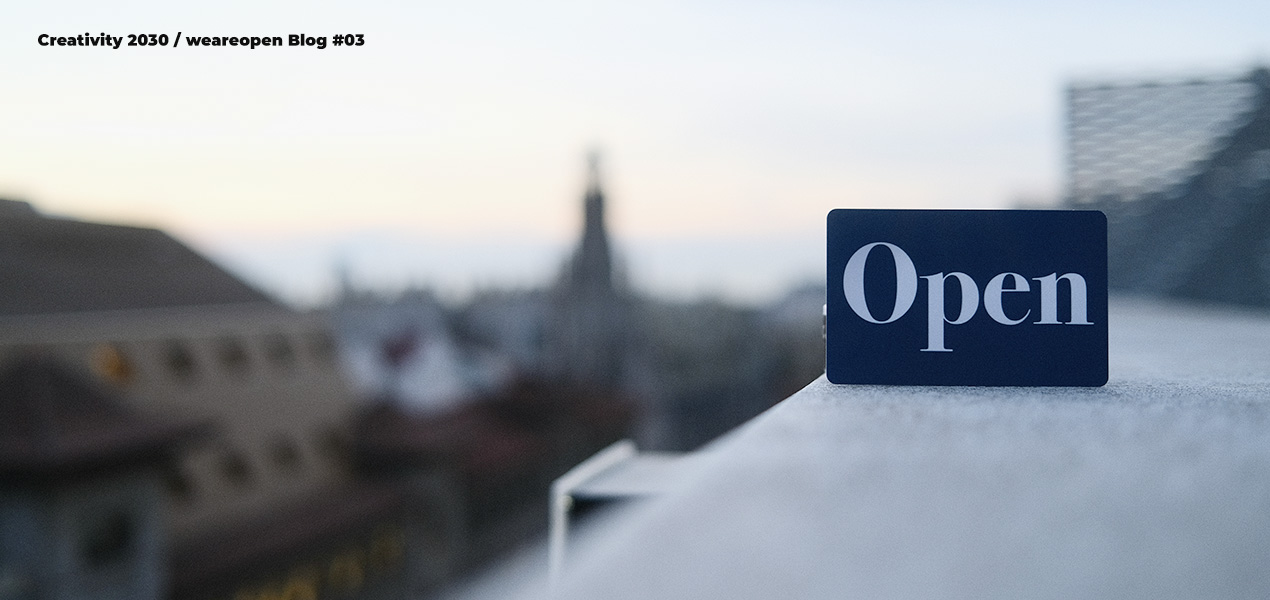“There are two ways to fail with absolute certainty: The first is to abandon rationality, the second to trust it blindly.”
– Blaise Pascal, mathematician and philosopher.
The biggest risk for businesses today isn’t disruption. It’s playing it safe. Sticking to the proven, the measurable, and the predictable might feel like the smartest move—but in a world changing this fast, that’s exactly what will hold you back.
From workplace well-being to sustainable growth to AI-driven transformation, companies today face a fundamental choice: Keep optimizing what already exists. Or open themselves to rethinking how they operate, compete, and create value. The first path often seems safer–but only in the short-term, as the second path is where reinvention happens. We propose the latter: embracing the transformative power of openness.
Openness: the one (and only) factor that’s guaranteed success throughout human history
Openness isn’t just the key ingredient in creative thinking. It’s the foundation of progress, innovation, and long-term business survival. Yet most companies resist it. Not because they don’t value creativity—but because openness demands comfort with uncertainty. And uncertainty doesn’t fit neatly into a KPI dashboard.
Johan Norberg’s book Open – The Story of Human Progress makes an unignorable case for openness: the single most deciding factor in humanity’s progress has been the courage not to make immediate decisions, daring to keep processes and decisions open as long as possible (but not longer). Our biggest leaps–in civilizations, business, and individually, too, have been fueled by the ability to remain open to new ideas, partnerships, and ways of thinking. The companies that thrive are not the ones that rush to premature certainty. They are the ones that dare stay open for as long as possible. Uncomfortable? Very likely. A competitive advantage? Absolutely.
AI won’t guarantee the future of your Brand. Open just might.
Embracing openness as a business strategy is particularly urgent now as AI reshapes industries at an unprecedented pace, yet many companies are rushing to integrate AI Businesses are rushing to integrate AI—automating decisions, cutting costs, optimizing processes–without questioning what they actually want it to achieve.
Some businesses see AI as a tool for efficiency. They use it to make what already exists run faster, cheaper, and smoother. Other businesses see AI as an enabler of reinvention. They use it to explore, to augment human creativity, to rethink the nature of work itself. One of these approaches leads to more of the same, just faster. The other leads to entirely new ways of creating value.
The companies that treat AI as just another optimization tool will fall behind. The ones that use AI to expand their creative capacity—to experiment, imagine, and rethink assumptions—will define the next era of business.
Openness is what makes the difference. What new possibilities could AI unlock if we allowed it to augment human creativity rather than replace it?
The Future Favors the Open
We learned this firsthand when we founded We Are Open in December 2020. We didn’t start with a rigid business plan. We started with a belief—that openness itself was the missing ingredient in business transformation.
Openness to new ways of working. Openness to new ways of thinking. Openness to new ways of collaborating. Openness to accept that you don’t always have the best idea.
It wasn’t the easiest path. Openness means operating without guarantees, trusting instincts before all the data is there, and making space for uncertainty. But it also led to our biggest breakthroughs.And that’s the point: the best decisions don’t always begin with certainty. They begin with openness.
Companies today face the same choice: They can either proactively shift their culture toward openness—seeing their role as building something new that works better for all—or be left behind by forces bigger than them. The businesses that cling to certainty and efficiency alone will find themselves in the position of California’s famed vineyards—drying up in a drought they played no part in creating.
We want to be crystal clear: openness is not indecision. It is not procrastination. And it is certainly not about rejecting data. Openness, at its best, is a strategic advantage. It is driven by both intuition and information—thus avoiding both of Pascal’s paths to failure.
Open is the best method we know to move from incremental change to leaps of progress. That’s why we chose Open—both as our name and as our method. Open frees us from what is, and lets us imagine, then build, better ways of working, and better companies.
What will open look like for you?
The first step toward openness is a leap of faith. It starts with daring to declare, “We don’t know… yet.”
Open is not a policy. Open is a practice. It’s a way of operating that fosters trust, curiosity, and creative confidence. A feeling that I am trusted, and I can trust others. A feeling that we don’t need all the answers upfront—that knowing where we want to go matters more than having a perfect roadmap to get there.
Open frees us from the straitjacket of best practices. It stops us from copy-pasting what worked yesterday and mistaking it for the best strategy for tomorrow.
And that’s not a bad start.
Because the future belongs to those who don’t just change the ink cartridge in the photocopier—but to those who dare to design something entirely new.
This post by We Are Open and more for Creativity 2030 initiative here; https://www.mrktng.fi/luovuus/

No Comments.